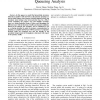Free Online Productivity Tools
i2Speak
i2Symbol
i2OCR
iTex2Img
iWeb2Print
iWeb2Shot
i2Type
iPdf2Split
iPdf2Merge
i2Bopomofo
i2Arabic
i2Style
i2Image
i2PDF
iLatex2Rtf
Sci2ools
ICC
2009
IEEE
2009
IEEE
Cooperative Cognitive Radio with Priority Queueing Analysis
In this paper, we model the hierarchical structures inherent in cognitive radio networks as the priority queueing system in which primary users interact with the highest priority and secondary users belong to the lowest priority class. In a M/G/1 system containing one primary user and multiple secondary users, we obtain analytical forms of delay and throughput for different users with the function of traffic and channel conditions. Based on the analysis, the secondary user is considered to act as a relaying terminal to assist the primary communication by adopting an amplify-and-forward TDMA protocol. Cooperative diversity gains are examined next and the benefits of the secondary: improvement of throughput, is discussed with respect of the primary traffic.
| Added | 18 Feb 2011 |
| Updated | 18 Feb 2011 |
| Type | Journal |
| Year | 2009 |
| Where | ICC |
| Authors | Caoxie Zhang, Xinbing Wang, Jun Li |
Comments (0)

